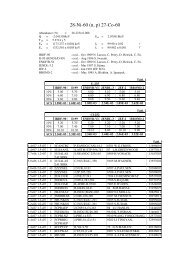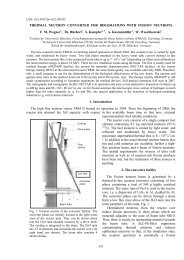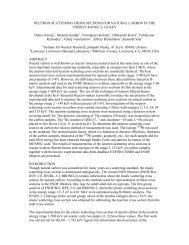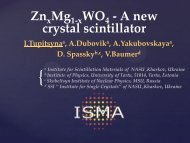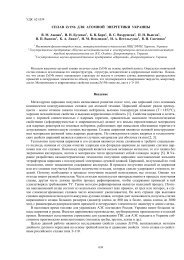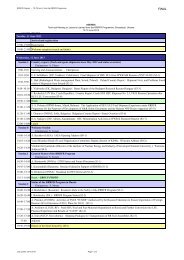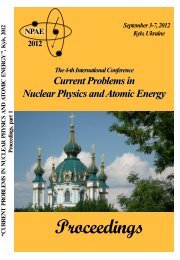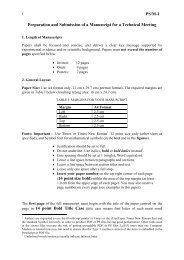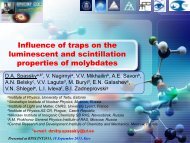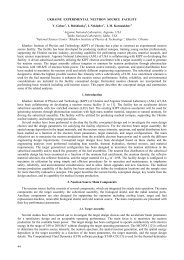International Reactor Dosimetry File 2002 - IAEA Publications
International Reactor Dosimetry File 2002 - IAEA Publications
International Reactor Dosimetry File 2002 - IAEA Publications
You also want an ePaper? Increase the reach of your titles
YUMPU automatically turns print PDFs into web optimized ePapers that Google loves.
cross-sections in this manner, the very fine group cross-sections can then be<br />
collapsed to coarser group structures, which may be used in the neutron<br />
adjustment codes. Alternatively, computer codes have been developed to<br />
perform calculations of the neutron self-shielding corrections using the neutron<br />
resonance parameters directly. Although this process may be time consuming,<br />
the set of shielded activation cross-sections can be used routinely as long as the<br />
same geometry foils or wires are used, regardless of the application.<br />
II.3. TABLES OF NEUTRON SELF-SHIELDING CORRECTIONS<br />
Neutron self-shielding correction factors have been experimentally<br />
determined by irradiating foils or wires of varying thickness, with and without<br />
cadmium covers. The relevant tables can be found in the literature, for example<br />
in ASTM Standard Test Method E262 for Determining Thermal Neutron<br />
Reaction and Fluence Rates by Radioactivation Techniques. However, these<br />
tables list the neutron self-shielding corrections separately for the thermal and<br />
resonance integrals of only a few types of material, including cobalt, gold and<br />
indium. While such data can be used to determine corrections to very simple<br />
reactor dosimetry experiments involving only these types of material or for<br />
estimating the magnitude of such corrections, they are not generally applicable<br />
to reactor dosimetry applications. Furthermore, this approach is not<br />
appropriate to neutron spectral adjustment procedures, since the tabulated<br />
data can only be used to correct reaction rates prior to spectral adjustment. The<br />
neutron cross-sections are preferably shielded rather than the reaction rates.<br />
Spectral adjustments will then not depend on any prior assumptions concerning<br />
the thermal or epithermal neutron flux.<br />
II.4. APPROXIMATION FORMULAS COMMONLY USED FOR<br />
NEUTRON SELF-SHIELDING<br />
<strong>Reactor</strong> dosimetry measurements are frequently performed with<br />
relatively small foils or wires of such a size that the mean free path for neutron<br />
scattering tends to be larger than the sample dimensions. Therefore, the<br />
neutron self-shielding factor can be approximated by neglecting the neutron<br />
scattering effects. Formulas can then be derived to determine the neutron selfshielding<br />
for any given geometry, assuming an isotropic neutron flux. Such an<br />
assumption is generally acceptable for the thermal and epithermal neutron<br />
flux, and the derivation of such formulas is given in Refs [II.2, II.3]. Neutron<br />
self-shielding calculations should be performed for each neutron cross-section<br />
111



